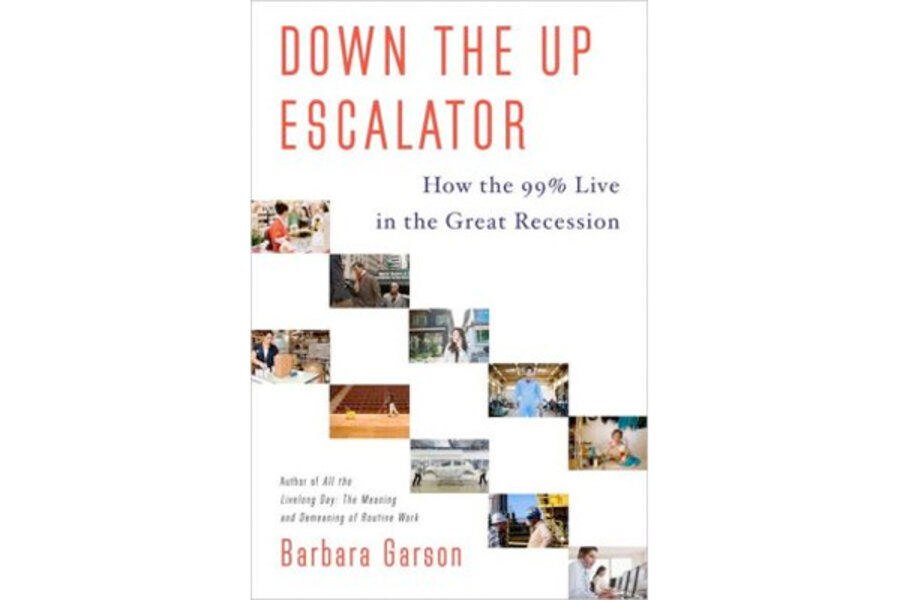Down the Up Escalator
Loading...
The generation that went to Woodstock, fought with police against the Vietnam War, and later, enjoyed a "me" decade – the "Baby Boomer" generation – has taken part in transforming our economy into a system that many regard as genuinely hostile to "the people."
Now a participant in 1960s social activism has written a book showing in sharp relief the impact of decades of downsizing and outsourcing on families and on some of the good-paying jobs that once sustained the American middle class.
Down the Up Escalator: How the 99% Live in the Great Recession is a three-part opus in which Barbara Garson befriends and tells the stories of people who can't find work, people who are losing their homes, and people whose savings have evaporated.
Amid this contemporary Brothers Grimm collection are Garson's savvy views on how chunks of America ended up on a down escalator. She comments, "[U]nlike the Great Depression, the Great Recession didn't narrow the wealth gap.... For all our bruises we merely went into a deep pothole and emerged on the same rough and dangerous road."
Many of Garson's stories are heartbreaking. She tells of Alice Epps from California. When the interest on her adjustable-rate mortgage rose to 17 percent and then her son was murdered, she got behind on payments. Her herculean efforts to arrange a loan modification, and the thousands she paid in fees, did virtually nothing to reduce her debt or enable her to keep her home.
Some may disagree with Garson's view that too much capital has been invested in buying out competing companies, in real estate speculation, and in other schemes that do nothing to create new businesses and jobs to replace the well-paid ones lost in manufacturing and other business sectors. Others might take issue with her statistics, which often come from sources with a strong liberal bias. But there is no arguing with what's happened to millions of people who, during an earlier era, would be thriving, not struggling to survive.
And Garson is the perfect person to write a book about economic injustice. Since the '60s, she has been reporting on and advocating for populist issues. She played a key role in the Berkeley Free Speech Movement and she's written three other books on work and our financial system.
"Down the Up Escalator" starts with the stories of four funky New Yorkers she calls the "Pink Slip Club." Garson describes the frustrations and indignities these professionals suffer looking for work after losing their jobs early in the recession. Garson keeps track of them for several years as they all fail to win back mid-level white-color positions.
Elaine, who'd worked in accounts payable for a broadcasting conglomerate, eventually starts to fantasize about scoring some hours helping in a hole-in-the-wall shop that converts records to CDs. Gerri, who had been an insurance adjuster, experiences similar disappointments, and becomes increasingly anxious as expenses bite chunks out of her shrinking savings. (Garson named these members of the Pink Slip Club after two of the main characters from the Seinfeld TV series.)
Then there are the men. Feldman, previously a very busy graphics designer, was finding that even temp work was scarce. Kevin, who'd been an editor at a trade journal, was struggling because he felt employers preferred hiring recent graduates to experienced professionals in their 50s.
Garson is an excellent storyteller. And she's a good listener – even, apparently, in this book when interviewing individuals involved in the type of financial manipulation that yanked our economy to its knees.
But one inherent weakness of a collection like this is that it can't possibly tell the full story of what's happened to working families. And even during the recession, many people continued to do just fine. Meanwhile, Garson spends a lot of time talking to New Yorkers and Californians, whose crises represent only part of the picture.
So I particularly liked her profile of the Kenny family in Evansville, Ind. Some may disagree with the description Garson provides of Evansville, as a hollowed-out small city where many traditional employers have left. But it's certainly true that manufacturers have largely disappeared from American cities, resulting in reduced employment prospects for many.
The dad here works for a Big Box retailer that is pressuring him in nasty ways to retire early so they can hire a younger, cheaper worker. And the adult son – an intelligent young man who in another place and time would find plenty of work – designs Grateful Dead T-Shirts.
The senior Kenny provides an illustration of a worker who has labored diligently but has little to show for it. "[S]tarting around the mid-1970s," Garson says, "the wealth gap widened while hourly wages stagnated or declined." She argues that, "Between 1976 and 2007, 58 percent of every new dollar of income generated went to the top 1 percent of households."
Now it's 2013; stock prices have rebounded, many people have found jobs, and the housing crisis has receded. But our unemployment rate remains high, and as Garson's anecedotal examination of the American economy would suggest, millions of individuals and families are still hurting.
Garson asks at the end of her book: "How many times can we emerge [from a recession] with the rich richer, the poor poorer, and more of the middle class marginalized? ... What happens to a market economy when all the money winds up in one pocket?"
Garson's book clearly doesn't provide a balanced view, and the stories she presents are more a stream-of-consciousness-style effort than a scientific sampling. Yet her book of stories is a convincing effort to show that the recession was part of ongoing restructuring – a restructuring at least partially motivated by greed – that is making it hard for many Americans to ride up the economic escalator.
David Hugh Smith is a communications specialist in Brookline, Mass., who recently started a full-time job after many months of underemployment.








